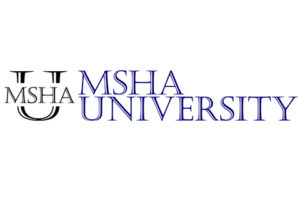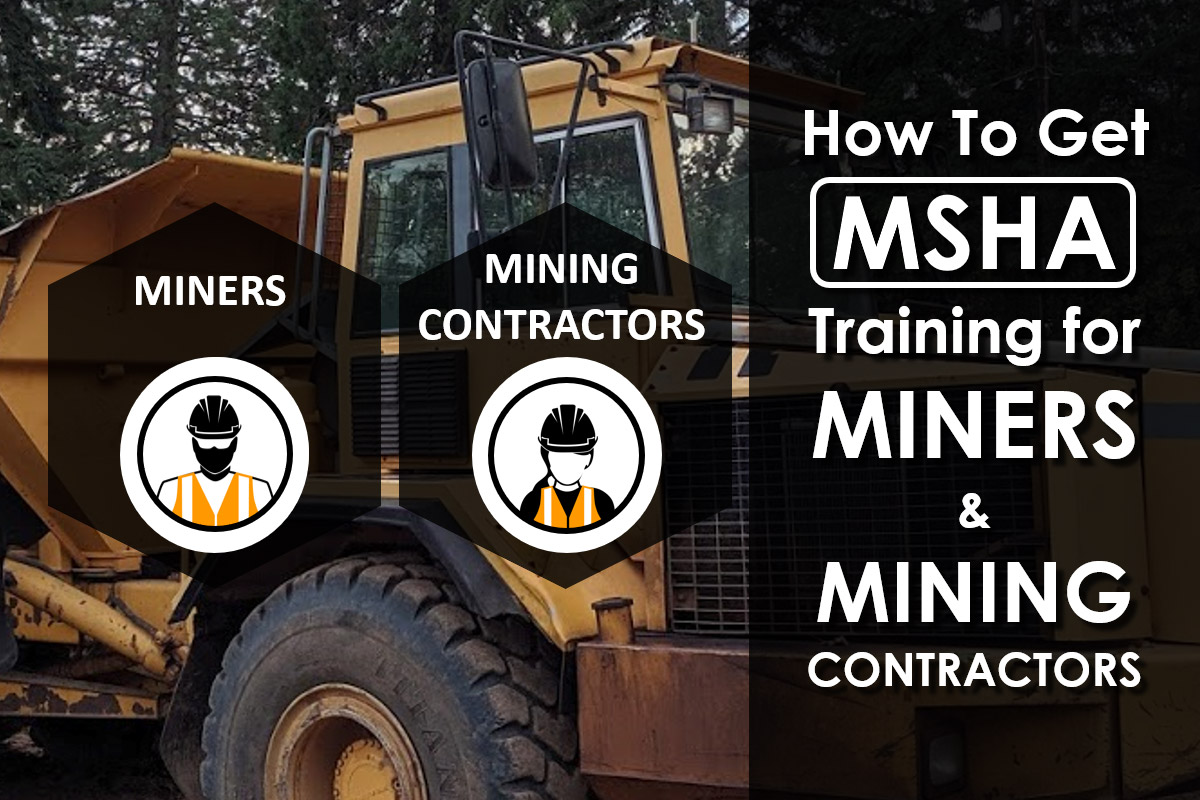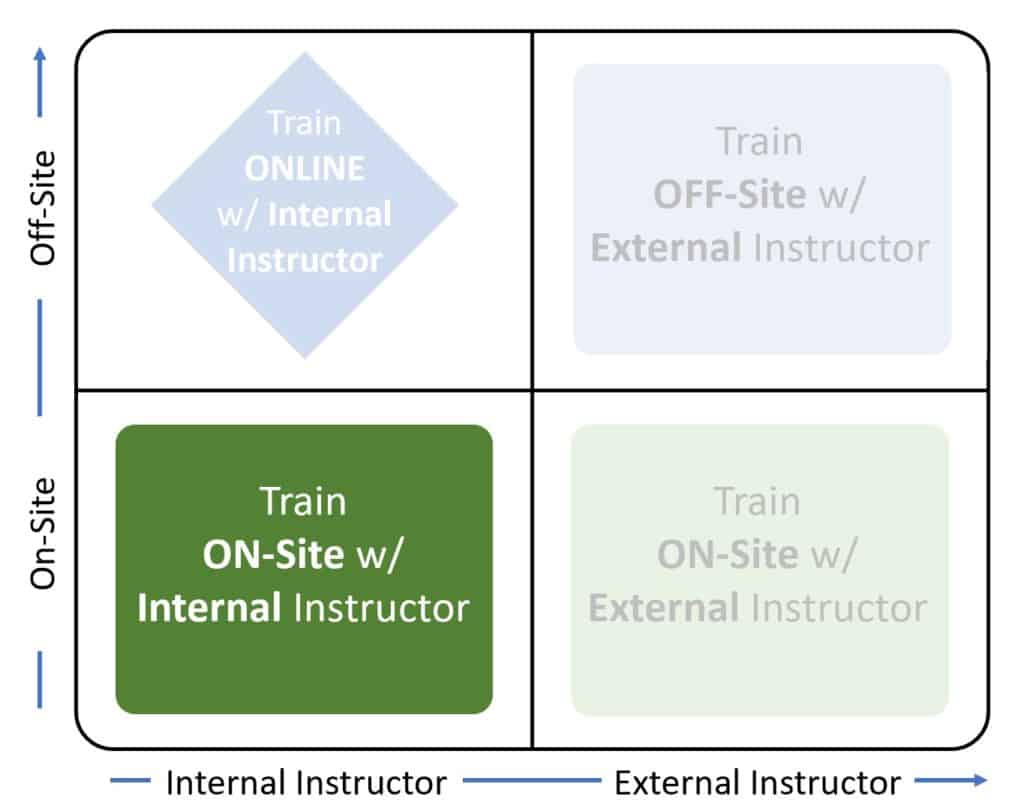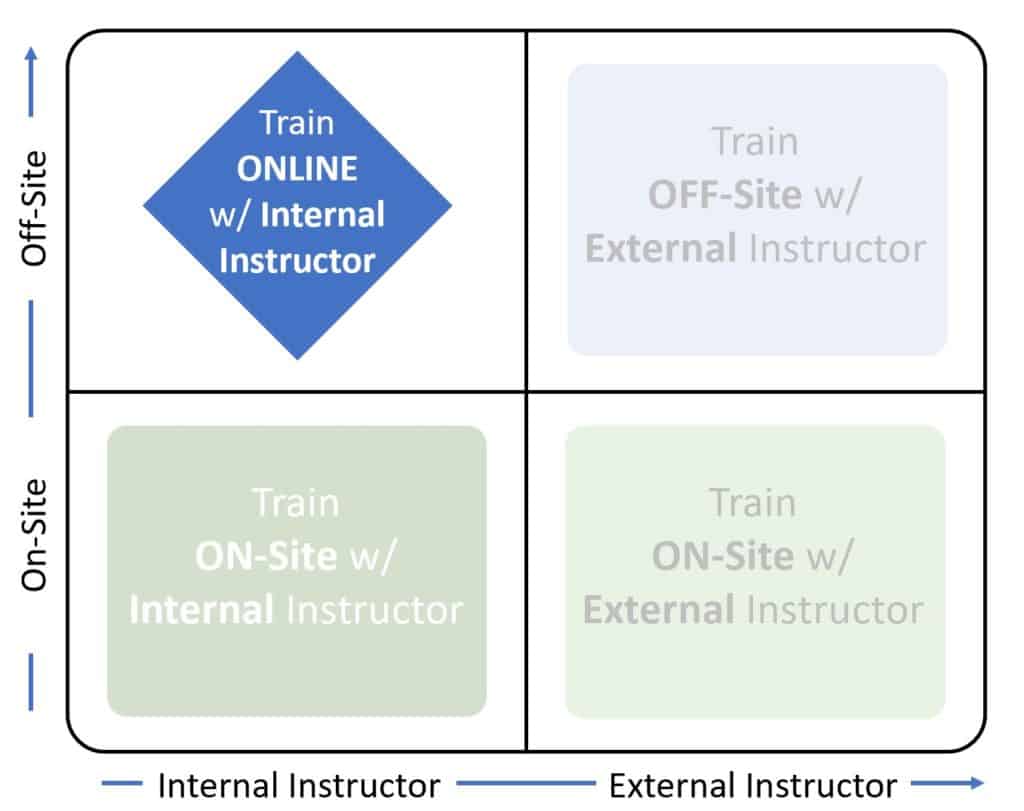The Mine Safety and Health Administration (MSHA) outlines training and annual retraining requirements for surface miners (Part 46) and underground miners (Part 48) in Title 30 of the Code of Federal Regulations. And while all the specific training topics and minimum amounts of training for each training program are spelled out in the federal regulations, neither Part 46 nor Part 48 requirements offer insights into options for getting your team properly trained.
So, how do you get MSHA training for your miners and mining contractors? You can get MSHA training for your miners and mining contractors in these 4 basic ways:
- Train your team on-site with and employee instructor
- Train your team on-site with an external instructor
- Send your team to be trained off-site
- Train your team online
Most mine operators who’ve been in business for a while probably have a fully established training plan in place, making sure that new miners get started with compliant training and everyone on their team receives required annual refresher training. But whether you’re a mine operator looking for other options or a mining contractor about to begin work at a mine, this article should help offer some much-needed guidance to point you in the right direction.
Throughout this article, we’ll refer to some of the basic training requirement differences between Part 46 and Part 48 regulations. While the training options we’ll review are primarily the same, the ways in which MSHA enforces the regulations around those options can be completely different. And to stay compliant, it’s critical to understand MSHA’s perspective.
So, what are the most common training options for you to get and stay compliant? Let’s go through each one in more detail to find out which one is right for you.
1 – Train Your Team On-Site With An Employee Instructor
MSHA’s training requirements for both Part 46 and Part 48 are fundamentally designed for training your team on-site with your own competent person or MSHA approved instructor. This is your most basic and readily accessible option.
Part 46 requires that training be delivered by a “competent person” who has the “ability, training, knowledge, or experience to provide training to miners.” This is a person deemed competent in specified training subjects by the mine operator and named on both the training plan and record of training. A mine’s competent person is often an employee, like the safety manager, but may also be a non-employee, like a consultant or an MSHA approved instructor (which we’ll cover in the next section). And the mine or mining contractor can name as many competent persons in their training plans as they like.
Part 48 requires that all training be delivered by an MSHA approved instructor. An MSHA approved instructor is a person who’s completed an MSHA training course designed to qualify them to provide compliant instruction to miners at Part 48A underground and Part 48B surface areas of underground mines. MSHA approved instructors must also me specifically named in the Part 48 training plan.
While MSHA approved instructors will primarily focus on providing Part 48 training, they are automatically considered approved to train Part 48 surface miners.
Estimated Costs – The cost of conducting on-site training will vary based upon the number of employees you’ll train and their normal rates during training as well as the number of instructors who provide training throughout your programs.
For example, based on Bureau of Labor Statistics wages for miners and mining supervisors in a training scenario with 5 trainees and one instructor, here’s a very rough estimate of costs:
- For 24 hours of Part 46 new surface miner training, at $20/hr per miner (x 5 miners) and $34/hr for one competent person, the cost in wages alone could be roughly $3,254.
- For 40 hours of Part 48 underground coal miner training, at $26/hr per miner (x 5 miners) and $41/hr for one MSHA approved instructor supervisor, the cost in wages alone could be roughly $6,926.
PRO –
- Cost-Effective – No need to pay for employee travel time and off-site expenses.
- Ultimate Control – Company leadership has full control over all aspects of training (scheduling, trainers, content, location, etc.)
CON –
- Added Effort – Takes some effort and resources to develop compliant training materials, schedule, and manage an in-house training facility.
TIP! – It’s important to understand that MSHA’s original intent was for the mine employer, the mine operator or mining contractor, to provide training. It was not intended that an individual take MSHA training as a requirement for employment at a mine. I’ve received numerous calls over the years from prospective mine employees told by a union representative that they “need to get their MSHA training” before applying for a mining job. This just isn’t the case. MSHA requires that the employer provide the training and that the trainee is paid during training. So, be sure to take advantage of that and avoid wasting time, effort, and money if you’re on your own and looking for employment at a mine.
2 – Train Your Team On-Site With An External Instructor
While Parts 46 and 48 regulations are designed for employers to provide the own training, MSHA makes no requirement that all competent persons and MSHA approved instructors must be mine employees. So, securing external resources for training miners and mining contractors on-site is perfectly acceptable.
You can potentially find local resources by searching online for MSHA instructors or by reviewing MSHA’s State Grant Program list of contacts. Your local contacts from MSHA’s list should be able to connect you with appropriate training resources.
Whoever you bring on-site as an instructor for both Part 46 and Part 48, they must be named in your training plan and aligned with subjects each instructor is qualified or competent to teach.
Estimated Costs – In a training scenario with 5 trainees and one external instructor, we’ll use the same hourly wages for the miners and simply add a very rough estimate for the external instructor’s time:
- For 24 hours of Part 46 new surface miner training, including miner wages and the estimated cost for one external instructor, the cost could be roughly $4,754.
- For 40 hours of Part 48 underground coal miner training, including miner wages and the estimated cost for one external instructor, the cost could be roughly $9,427.
PRO –
- Still Somewhat Cost-Effective – No need to pay for employee travel time and off-site expenses.
- Less Effort – Relying on a competent external resource to provide required training can result in less effort on mine staff to prepare and deliver training material.
CON –
- Increased Cost – Can increase cost compared to training with instructors who are employees.
- Inflexible Scheduling – It can be difficult to schedule time with an external instructor when training is needed urgently. Instructors may have very full and inflexible schedules.
TIP! – Go to our RESOURCES page for a link to MSHA’s State Grant Program.
3 – Send Your Team To Be Trained Off-Site
While training your team off-site can be an effective option, there are a number of variables and associated costs that can make off-site training logistically difficult and prohibitively expensive. Added travel times, transportation costs, accommodations, meals, and the per person training fees can result in significant expenditures for off-site training. But if your budget and schedules allow you the flexibility to send your team to an off-site training facility, this may be a great option for you.
Similar to researching external training consultants, you’ll likely start with an online search for miner training facilities near you. Again, MSHA State Grant Program may offer a contact for your state or region who can point you in the right direction.
Estimated Costs – For 5 trainees sent to an off-site facility, we’ll use the same hourly wages for the miners and add estimates for training fees and travel expenses, including lodging, meals, and transport.
- For 24 hours of Part 46 surface new miner training, including miner wages, expenses, and training fees, the cost could be roughly $9,104.
- For 40 hours of Part 48 underground miner training, including miner wages, expenses, and training fees, the cost could be roughly $16,677.
PRO –
- Least Effort – Requires only scheduling trainees to be off-site. Instructors and the training facility take car of the rest of the training requirements.
- Qualified Instruction – Trainers at off-site facilities can provide a quality training experience with access to content, simulation equipment, and technology that may be unavailable at your site.
CON –
- Very Expensive – Due primarily to travel expenses, off-site training is the most expensive potential option.
- Accessibility – Not all mine operators and mining contractors have access to a training facility within a reasonable distance to make off-site training feasible.
- Availability – Coordinated off-site training when you need it can be difficult depending upon the training facility’s schedule and availability.
- No Control of Content – The content your team will be exposed to will be at the discretion of the trainer and the facility.
4 – Train Your Team Online
MSHA considers computer-based or online training to be a teaching method that does not take the place of a competent person or MSHA approved instructor. In fact, MSHA still requires that an instructor remain available for questions during online training. And there are some very important differences between Part 46 and Part 48 when it comes to online training.
In recent years, online MSHA training has become very prevent, especially for Part 46 surface miner training for new miner and annual refresher training programs.
Estimated Costs – For 5 trainees and one instructor remaining available during online training, we’ll use the same hourly wages for the miners, plus the instructor’s time and the per person cost of online training:
- For 24 hours of Part 46 surface new miner training, including wages plus $150 per trainee, the cost could be roughly $4,004.
- For 40 hours of Part 48 underground miner training, including wages plus $499 per trainee, the cost could be roughly $9,422.
PRO –
- Cost-Effective – No need to pay for employee travel time and off-site expenses.
- Less Effort – No need to develop your own training content, schedule training, and manage in-house training facility.
- Flexible Scheduling – Very easy to have trainees schedule and take self-paced online training.
CON –
- Can Cost More – Can be slightly more expensive per trainee than on-site training with an internal instructor.
- No Control of Content – The content your team will be exposed to will be at the discretion of the online training provider.
- Competent Person / Instructor Availability – Since MSHA still requires that the competent person or MSHA approved instructor remains available during online training, coordinating this may be an added logistic of online training use.
TIP! – Remember that the online training company may provide a record of training or even an MSHA 5000-23 Certificate of Training. But your responsible person will still be the one who signs and certifies the training records.
TIP! – Check out our article on online training, “Yes, MSHA Accepts Online Training – 5 Key Tips For Compliance” for additional insights into how MSHA views and regulates online training for both Part 46 and Part 48.
TIP! – For online training options, check out our RESOURCES page.
5 – Training Cost Comparisons
Based on these rough cost estimates, here’s how the different training options stack up.
| Training Options | Part 46 | Part 48 |
| On-Site Internal Trainer | $3,252 | $6,927 |
| Online | $4,004 | $9,422 |
| On-Site External Trainer | $4,754 | $9,427 |
| Off-Site | $9,104 | $16,677 |

Estimate Variables – Cost estimates are provided to help assess relative cost differences per training option. All estimated costs are based on a variety of sources to the best of our ability and knowledge as of October 2019. Your costs for training may vary greatly based on:
- Miner and supervisor wages
- Instructor wages and fees
- Training facility fees
- Travel expenses
- Online training fees and subscriptions
6 – Important Things To Remember
Regardless of how you decide to train your team, here are a few things to keep in mind:
Documentation – Both MSHA Part 46 and Part 48 require similar documentation. All mine operators and mining contractors must maintain a compliant training plan. While Part 46 allows mine operators and contractors to create their own compliant training plans, Part 48 requires that training plans be submitted to and approved by MSHA.
When a training program has been successfully completed by trainees, records of training must also be produced and kept on file. For Part 46, MSHA allows for the use of either a compliant record of training or a 5000-23 Certificate of Training. But for Part 48, the 5000-23 Certificate of Training is required.
Paying Trainees – MSHA requires that trainees are paid at their normal rate during training, whether on-site, off-site, or online.
MSHA Approved Instructors – While a Part 48 MSHA approved instructor is also qualified to provide training to Part 46 miners, that doesn’t automatically make them a mine’s competent person. The mine operator or mining contractor is still required to name the MSHA approved instructor as a competent person in specified training subjects on the written training plan.
Training Timing – While Part 46 requires a minimum of 4 hours of the total 24 hours of training to be completed prior to beginning work at the mine, it’s very common for mine operators and mining contractors to have trainees complete the full 24 hours in 3 consecutive 8-hour days of training. Part of the reasoning for this approach is to provide one cohesive block of training and avoid having to manage multiple sessions with separate deadlines. This can also provide mine operators some assurance that miners and contractors are more prepared with a greater scope of training prior to beginning work.
Competent Person Availability – During Part 46 training, a competent person must remain available to answer questions. This is very important to keep in mind when trainees take self-paced online training at random times throughout a work day. For Part 48, the MSHA approved instructor must also remain available for questions during training.
The Responsible Person Signs Training Records – While many people continue to be confused about who signs either a compliant record of training or an MSHA 5000-23 Certificate of Training, let’s clear that up right now. It’s NOT the trainer or MSHA approved instructor who signs and certifies that training has been completed. It’s the responsible person, the person deemed responsible for health and safety training for the mine or mining contractor company, who signs and certifies the records of training. However, in some cases, the competent person may also be named as the responsible person in the training plan. If that’s the case, then of course that same person can sign the record of training.
Related Questions
Does MSHA accept online training?
Yes! MSHA accepts online training as a teaching method for both Part 46 and Part 48. However, there are some important differences in how MSHA views online training for the different regulations.
Check out our article on online training, “Yes, MSHA Accepts Online Training – 5 Key Tips For Compliance” for additional insights into how MSHA views and regulates online training for both Part 46 and Part 48.
What’s the different between a competent person and an MSHA approved instructor?
A competent person is described in Part 46 regulations for surface miner training. This is a person designated by the mine operator or mining contractor as competent to train miners in specific subjects.
An MSHA approved instructor is described in Part 48 regulations for underground miner training. This is a person who has completed an MSHA course designed to qualify them to train underground miners on required subjects.
Check out our article, “MSHA Training – The 6 Most Important Roles” for more details on these and other important MSHA training roles.
What’s the difference between MSHA Part 46 and Part 48?
There are loads of differences between MSHA Part 46 surface miner training and Part 48 underground miner training regulations. However, the 3 primary types of differences boil down to:
- The types of mining each regulation covers,
- The training requirements for miners and mining contractors, and
- The specific ways that MSHA oversees and enforces these two sets of regulations.
Check out our article, “3 Major Differences Between MSHA Part 46 and Part 48” for more details on the critical differences between these two MSHA regulations.






